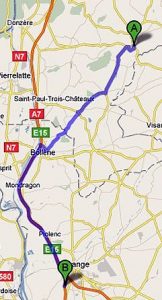We are nearing the end of our year living in Europe. One of our goals for this trip was to experience the rich Roman and Medieval history in the area – most of which requires driving south. It is very quick to get around France once you are on the freeway, but freeway entrances are fairly far apart.
From our house, you can get on the freeway by driving north or south. The south entrance, we will call this Route A, is further away, but is in the right direction once you are on the freeway. Here is the Google Map from close to our house to the town of Orange.

The north freeway entrance, we will call this Route B, is closer, but is north from where we live so takes you out of the way. However, you spend more of the time driving freeway speeds. Here it is on Google Maps.

Now here’s the thing – my husband and I do NOT agree on which route to take, and driving in the car offers plenty of time to discuss why our particular point of view is the correct one.
My husband started with the stats from Google Maps to support his point of view:
- Route A: 46.3 km, 47 minutes (shorter and faster)
- Route B: 64.3 km, 51 minutes (longer and slower)
I pointed out that Google Maps is based on algorithms and not reality, so suggested we do some real-life measurements. The next few trips south I wrote down our departure times and arrival times at a set point on the freeway both coming and going (yes, we are that kind of couple!) using both routes:
- Route A: 46 minutes, 58 minutes, 53 minutes, 52 minutes (faster 1 out of 4 times)
- Route B: 50 minutes, 52 minutes, 51 minutes, 49 minutes (faster 3 out of 4 times)
Now, it should be immediately obvious that my husband is an advocate of Route A, and I prefer Route B. And we both have data to prove that we are right. My husband would point out that my measurements were invalid since on the trips where Route A was slower we ran into unusual traffic. I would point out that if we ran into unusual traffic 3 out of 4 times it probably means that the traffic is not that unusual.
Of course, we should know better. He is an engineer and I am a mathematician. Before we started all our “fact finding,” we should have just put on the table that we are biased. I don’t like roundabouts, so getting on the freeway sooner is a way to avoid them. My husband finds the freeway boring and prefers going through the towns.
So back to the market research topic. In this case the final result doesn’t really matter. But in any market research project, it’s important to know and confront biases at the beginning of a project, so you can ensure they are addressed. Findings must be strong enough that exceptions that support existing biases are identified and understood.
